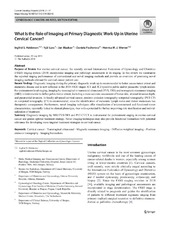| dc.contributor.author | Haldorsen, Ingfrid S. | en_US |
| dc.contributor.author | Lura, Njål | en_US |
| dc.contributor.author | Blaakær, Jan | en_US |
| dc.contributor.author | Fischerova, Daniela | en_US |
| dc.contributor.author | Werner, Henrica Maria Johanna | en_US |
| dc.date.accessioned | 2020-03-27T09:09:41Z | |
| dc.date.available | 2020-03-27T09:09:41Z | |
| dc.date.issued | 2019-07-29 | |
| dc.Published | Haldorsen IS, Lura N, Blaakær J, Fischerova D, Werner HMJ. What is the role of imaging at primary diagnostic work-up in uterine cervical cancer?. Current Oncology Reports. 2019;21:77 | eng |
| dc.identifier.issn | 1523-3790 | |
| dc.identifier.issn | 1534-6269 | |
| dc.identifier.uri | https://hdl.handle.net/1956/21600 | |
| dc.description.abstract | Purpose of Review For uterine cervical cancer, the recently revised International Federation of Gynecology and Obstetrics (FIGO) staging system (2018) incorporates imaging and pathology assessments in its staging. In this review we summarize the reported staging performances of conventional and novel imaging methods and provide an overview of promising novel imaging methods relevant for cervical cancer patient care. Recent Findings Diagnostic imaging during the primary diagnostic work-up is recommended to better assess tumor extent and metastatic disease and is now reflected in the 2018 FIGO stages 3C1 and 3C2 (positive pelvic and/or paraaortic lymph nodes). For pretreatment local staging, imaging by transvaginal or transrectal ultrasound (TVS, TRS) and/or magnetic resonance imaging (MRI) is instrumental to define pelvic tumor extent, including a more accurate assessment of tumor size, stromal invasion depth, and parametrial invasion. In locally advanced cervical cancer, positron emission tomography-computed tomography (PET-CT) or computed tomography (CT) is recommended, since the identification of metastatic lymph nodes and distant metastases has therapeutic consequences. Furthermore, novel imaging techniques offer visualization of microstructural and functional tumor characteristics, reportedly linked to clinical phenotype, thus with a potential for further improving risk stratification and individualization of treatment. Summary Diagnostic imaging by MRI/TVS/TRS and PET-CT/CT is instrumental for pretreatment staging in uterine cervical cancer and guides optimal treatment strategy. Novel imaging techniques may also provide functional biomarkers with potential relevance for developing more targeted treatment strategies in cervical cancer. | en_US |
| dc.language.iso | eng | eng |
| dc.publisher | Springer | eng |
| dc.rights | Attribution CC BY | eng |
| dc.rights.uri | http://creativecommons.org/licenses/by/4.0/ | eng |
| dc.subject | Cervical cancer | eng |
| dc.subject | Transvaginal ultrasound | eng |
| dc.subject | Magnetic resonance imaging | eng |
| dc.subject | Diffusion-weighted imaging | eng |
| dc.subject | Positron emission tomography | eng |
| dc.subject | Imaging biomarkers | eng |
| dc.title | What is the role of imaging at primary diagnostic work-up in uterine cervical cancer? | en_US |
| dc.type | Peer reviewed | |
| dc.type | Journal article | |
| dc.date.updated | 2019-12-13T12:28:36Z | |
| dc.description.version | publishedVersion | en_US |
| dc.rights.holder | Copyright 2019 The Author(s) | |
| dc.identifier.doi | https://doi.org/10.1007/s11912-019-0824-0 | |
| dc.identifier.cristin | 1719154 | |
| dc.source.journal | Current Oncology Reports | |

